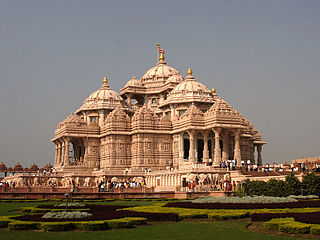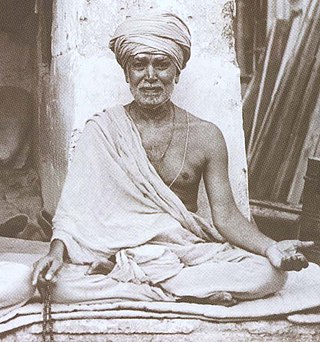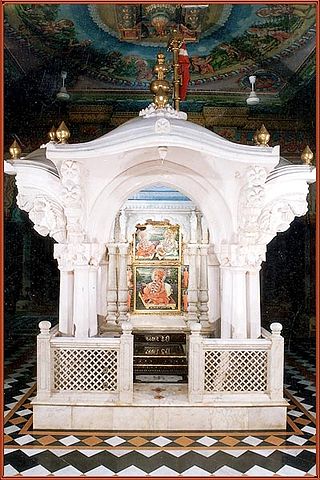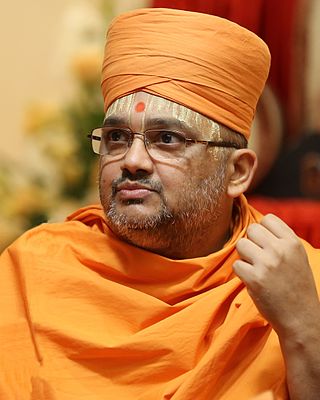
Avul Pakir Jainulabdeen Abdul KalamBR was an Indian aerospace scientist and statesman who served as the 11th president of India from 2002 to 2007. He was born and raised in Rameswaram, Tamil Nadu and studied physics and aerospace engineering. He spent the next four decades as a scientist and science administrator, mainly at the Defence Research and Development Organisation (DRDO) and Indian Space Research Organisation (ISRO) and was intimately involved in India's civilian space programme and military missile development efforts. He thus came to be known as the Missile Man of India for his work on the development of ballistic missile and launch vehicle technology. He also played a pivotal organisational, technical, and political role in India's Pokhran-II nuclear tests in 1998, the first since the original nuclear test by India in 1974.
Transcendence, transcendent, or transcendental may refer to:

Bochasanwasi Akshar Purushottam Swaminarayan Sanstha is a Hindu denomination within the Swaminarayan Sampradaya. It was formed in 1905 by Yagnapurushdas following his conviction that Swaminarayan remained present on earth through a lineage of gurus starting with Gunatitanand Swami.

Pramukh Swami Maharaj was the guru and Pramukh, or president, of the Bochasanwasi Akshar Purushottam Swaminarayan Sanstha (BAPS), a major branch of the Swaminarayan Sampradaya, a Hindu denomination. BAPS regards him as the fifth spiritual successor of Swaminarayan, following Gunatitanand Swami, Bhagatji Maharaj, Shastriji Maharaj, and Yogiji Maharaj. He was believed by his followers to be in constant communion with Swaminarayan, and ontologically, the manifestation of Akshar, the eternal abode of Swaminarayan.

Swaminarayan Akshardham is a Hindu temple, and spiritual-cultural campus in Delhi, India. The temple is close to the border with Noida. Also referred to as Akshardham Temple or Akshardham Delhi, the complex displays millennia of traditional and modern Hindu culture, spirituality, and architecture. Inspired by Yogiji Maharaj and created by Pramukh Swami Maharaj, it was constructed by BAPS.

Yogiji Maharaj, born Jina Vasani, was a Hindu swami and the fourth spiritual successor of Swaminarayan in the Bochasanwasi Akshar Purushottam Swaminarayan Sanstha (BAPS), a major branch of the Swaminarayan Sampradaya. According to the metaphysics of BAPS, Yogiji Maharaj is considered to be the next iteration of Akshar after Shastriji Maharaj in the guru parampara, an unbroken line of "perfect devotees" who provide "authentication of office through Gunatitanand Swami and back to Swaminarayan himself." Together with Pramukh Swami Maharaj, who acted as the administrative head of BAPS, he was instrumental in nurturing the growth of BAPS "through new programs, expansion into new areas, and the construction of temples". As guru, he consecrated over 60 temples and visited over 4000 towns and villages. He was particularly effective in attracting the devotion of youths and initiated a large number of them as ascetics. Furthermore, his multiple tours to Britain and East Africa were integral in the overseas expansion of BAPS. He died on 23 January 1971 after appointing Pramukh Swami Maharaj as his successor.

Swaminarayan Akshardham in Gandhinagar, Gujarat, India is a large Hindu temple complex inspired by Yogiji Maharaj (1892–1971) the fourth spiritual successor of Swaminarayan, and created by Pramukh Swami Maharaj (1921–2016), the fifth spiritual successor of Swaminarayan according to the BAPS denomination of Swaminarayan Hinduism. Located in the capital of Gujarat, the complex was built over 13 years and is a tribute to Swaminarayan and his life and teachings. At the center of the 23-acre complex is the Akshardham mandir, which is built from 6,000 metric tons of pink sandstone from Rajasthan. The complex's name refers to the divine abode of Swaminarayan in the BAPS philosophy; followers of Swaminarayan believe that the jiva or soul goes to Akshardham after attaining moksha, or liberation. BAPS followers worship Swaminarayan as God almighty.

The BAPS Shri Swaminarayan Mandir of Houston, Texas is a traditional Hindu temple built by the BAPS Swaminarayan Sanstha. It is in unincorporated Fort Bend County, Texas, within the extraterritorial jurisdiction (ETJ) of Stafford and with a Stafford mailing address.

The BAPS Shri Swaminarayan Mandir of Chicago, Illinois is a traditional Hindu place of worship built by the BAPS Swaminarayan Sanstha. The BAPS Swaminarayan Sanstha, which is headed by Mahant Swami Maharaj, is a denomination of the Swaminarayan Sampradaya within Hinduism. The mandir is located in the Chicago suburb of Bartlett and opened on August 7, 2004. It was built of hand-carved Italian marble and Turkish limestone. The mandir is the largest of its kind in Illinois and was constructed in accordance to the Shilpa shastras. The mandir complex spreads over 27 acres and includes the mandir and the haveli.

Shastriji Maharaj, born Dungar Patel and ordained Shastri Yagnapurushdas, was a swami of the Swaminarayan Sampradaya and founder of the Bochasanwasi Akshar Purushottam Swaminarayan Sanstha (BAPS). Several branches accept him as the third spiritual successor of Swaminarayan in the lineage of Aksharbrahma Gurus through whom Swaminarayan manifests, which began with Gunatitanand Swami. Born in a family of farmers in central Gujarat, India, he became a swami within the Vadtal diocese of the Swaminarayan Sampradaya at the age of 17 where he was given the name Yagnapurushdas Swami. The prefix Shastri was later added in recognition of his eminent scholarship in Sanskrit and the Hindu scriptures. He established BAPS after a doctrinal split from the Vadtal diocese of the Swaminarayan Sampradaya.
Akshar Purushottam Upasana is the BAPS-practice of worshiping Swaminarayan as a supreme being along with Gunatitanand Swami as his ideal devotee. It was formalized by Shastriji Maharaj from the teachings of Swaminarayan when he created the Bochasanwasi Shri Akshar Purushottam Swaminarayan Sanstha (BAPS) in 1907 after leaving the Swaminarayan Sampraday. It could also be referred to as Brahman Parabrahman Upasana or Bhakta Bhagwan Upasana. In this belief, Akshar and Para Brahman are worshiped together, and Para Brahman is present through the living ideal guru on Earth. Followers of BAPS regard Gunatitanand Swami as first the spiritual successor of Swaminarayan and then by Bhagatji Maharaj, Shastriji Maharaj, Yogiji Maharaj, Pramukh Swami Maharaj and Mahant Swami Maharaj..

The BAPS Shri Swaminarayan Mandir in Atlanta, Georgia is a traditional Hindu mandir, or place of worship, inaugurated on August 26, 2007 by the BAPS Swaminarayan Sanstha, a denomination of the Swaminarayan branch of Hinduism headed by Mahant Swami Maharaj. The mandir is located in the Lilburn suburb of Atlanta and was constructed in accordance with the Shilpa shastras, which are ancient Hindu architectural scriptures. It was the largest mandir of its kind outside of India. The mandir is made of 34,450 pieces of hand-carved Italian marble, Turkish Limestone and Indian pink sandstone, and are all situated on over 30 acres of landscaped grounds. The mandir complex also includes a large assembly hall, family activity center, classrooms, and an exhibition on the key tenets of Hinduism.

The Swaminarayan mantra, "Swaminarayan," is a mantra used by the Swaminarayan Sampradaya. It is a compound of two words: Swami and Narayan, that is, Vishnu c.q. Purushottam. According to the Swaminarayan-tradition, the Swaminarayan Mantra was introduced and explained by Swaminarayan, also known as Sahajanand Swami, spiritual head of the Swaminarayan Sampradaya, shortly after the death of his predecessor, Ramanand Swami. Devotees chant the Swaminarayan mantra to offer worship, to allay distress, to pray for the welfare of others, and at the end-of-life. Several scriptures of the Swaminarayan Sampradaya, such as the Swamini Vato, Harililamrut, and Bhaktachintamani, describe the power and efficacy of the Swaminarayan mantra for one who chants it.
Bhagatji Maharaj, born as Pragji Bhakta, was a householder devotee in the Swaminarayan Sampradaya, a Hindu denomination. He is regarded as the second spiritual successor of Swaminarayan in the Bochasanwasi Akshar Purushottam Swaminarayan Sanstha (BAPS).

The Akshar Deri is a major site of pilgrimage in the Swaminarayan Sampradaya and is located in the rang mandap of the BAPS Swaminarayan temple in Gondal, India. The structure marks the cremation site and serves as a memorial to Gunatitanand Swami. An event was held to commemorate 150 years of the structure in Gondal, the structure as well as the site was renovated to bring it to modern standards.

Bhadreshdas Swami is a Sanskrit scholar and an ordained monk of the Bochasanwasi Akshar Purushottam Swaminarayan Sanstha (BAPS). In 2007 he completed the Swaminarayan Bhashyam, a five-volume classical Sanskrit commentary on the Prasthanatrayi. This commentary on Hinduism's three canonical texts: the Upanishads, Bhagavad Gita, and the Brahma sutras, forms the interpretive foundation of the philosophy of Akshar Purushottam darshana, also known as Swaminarayan darshana, illuminating the Vedic roots of the Akshar Purushottama philosophy, which was propagated by the 19th-century Hindu leader, Swaminarayan and later by Shastriji Maharaj.
Swamiji, swami-ji, or swami ji is a variant of swami that is used as a direct form of address toward, or as a stand-in for the name of, a Hindu religious leader.

Mahant Swami Maharaj is the present guru and president of the Bochasanwasi Akshar Purushottam Swaminarayan Sanstha (BAPS), a major branch of the Swaminarayan Sampradaya, a Hindu denomination. BAPS regards him as the sixth spiritual successor of Swaminarayan, following Gunatitanand Swami, Bhagatji Maharaj, Shastriji Maharaj, Yogiji Maharaj, and Pramukh Swami Maharaj. He is believed by his followers to be in constant communion with Bhagwan Swaminarayan, and ontologically, the manifestation of Akshar, the perfect devotee of God.

Arun Kumar Tiwari is an Indian missile scientist, author, and professor. He has written several books and co-authored 5 books with Dr. APJ Abdul Kalam, including Wings of Fire, the autobiography of Dr. APJ Abdul Kalam, former president of India. Published in 1999, Wings of Fire has become a modern classic with over 30 reprints selling over a million copies and was translated into 18 languages.

Akshar-Purushottam Darshan or Aksarabrahma-Parabrahma-Darsanam, "Akshar-Purushottam philosophy," is a designation used by BAPS-swamis as an alternative name for the Swaminarayan Darshana, Swaminarayan's view or teachings, to distinguish it from other Vedanta-traditions. It is based on Swaminarayan's distinction between Parabrahman and Aksharbrahman as two distinct eternal realities, which in this view sets Swaminarayan's teachings apart from other Vedanta-traditions. It is an essential element for the BAPS and it's Akṣara-Puruṣottama Upāsanā ("worship"), in which Purushottam c.q. Parabrahman is present in a lineage of Aksharbrahman guru's, who are the abode (akshar) of God.
















